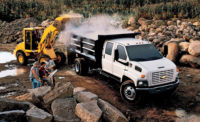EPA Floats New Fuel Efficiency Rules for Heavy-Duty Trucks

















The U.S. Environmental Protection Agency and National Highway Traffic Safety Administration have jointly proposed a new set of greenhouse-gas and fuel-efficiency rules for medium and heavy-duty trucks. If adopted, the rules would save U.S. households an average of $150 a year by 2030 if fleets pass fuels savings to customers, agencies say.
Announced June 19, the proposal is the second phase of a first-ever regulation that covers heavy vehicles built in the 2014-18 model years. The so-called Phase 2 standard would boost greenhouse-gas emissions and fuel economy by up to 24% for the 2021-27 model years.
"These efficiency standards are good for the environment—and the economy," says U.S. Transportation Secretary Anthony Foxx in a statement. "When trucks use less fuel, shipping costs go down." The rules cover buses, large pickup trucks and vans, large work trucks—such as concrete mixers—and tractor-trailers.
The standards do not prescribe which technologies engine and vehicle manufacturers will need to meet the cuts, but they may include advanced transmissions, engine combustion controls, aerodynamic improvements and low-rolling-resistance tires. The buyer of a new long-haul truck in 2027 would recoup the investment of new fuel-efficiency technologies in less than two years, regulators say.
Some trucking groups that generally support the regulation are still worried about the cost and durability of the new vehicles, though. Adding "an average of $12,000 to the cost of a new truck through mandates based on potentially untested technologies is a great risk to the still-fragile economy," says a joint statement from the National Automobile Dealers Association and American Truck Dealers.
"We believe this rule could result in the deployment of certain technologies that do not fully recognize the diversity of our industry and could prove to be unreliable," adds Bill Graves, president of the American Trucking Associations, in a statement.
EPA and NHTSA will hear public comments for 60 days, and a final rule is expected as early as 2016.








